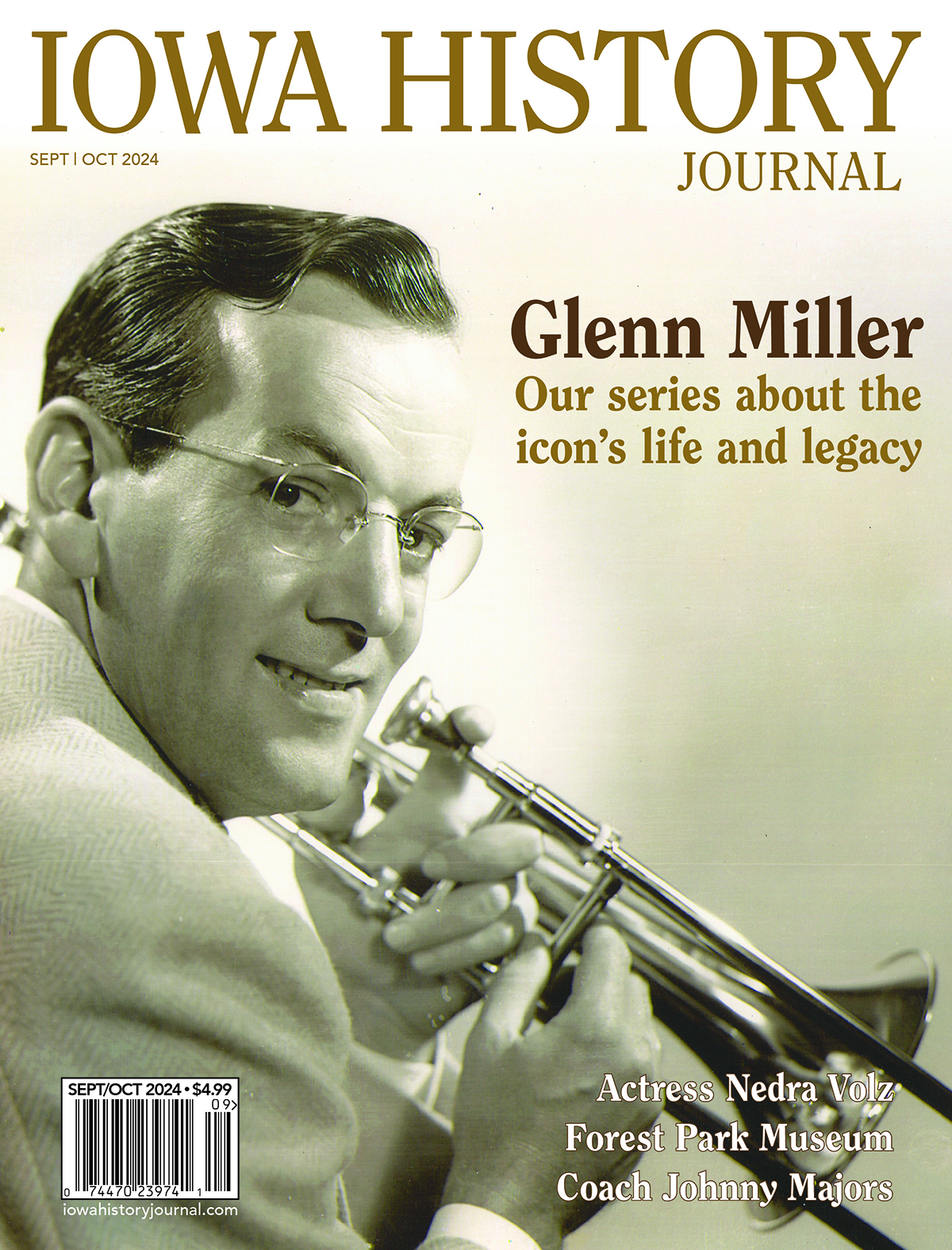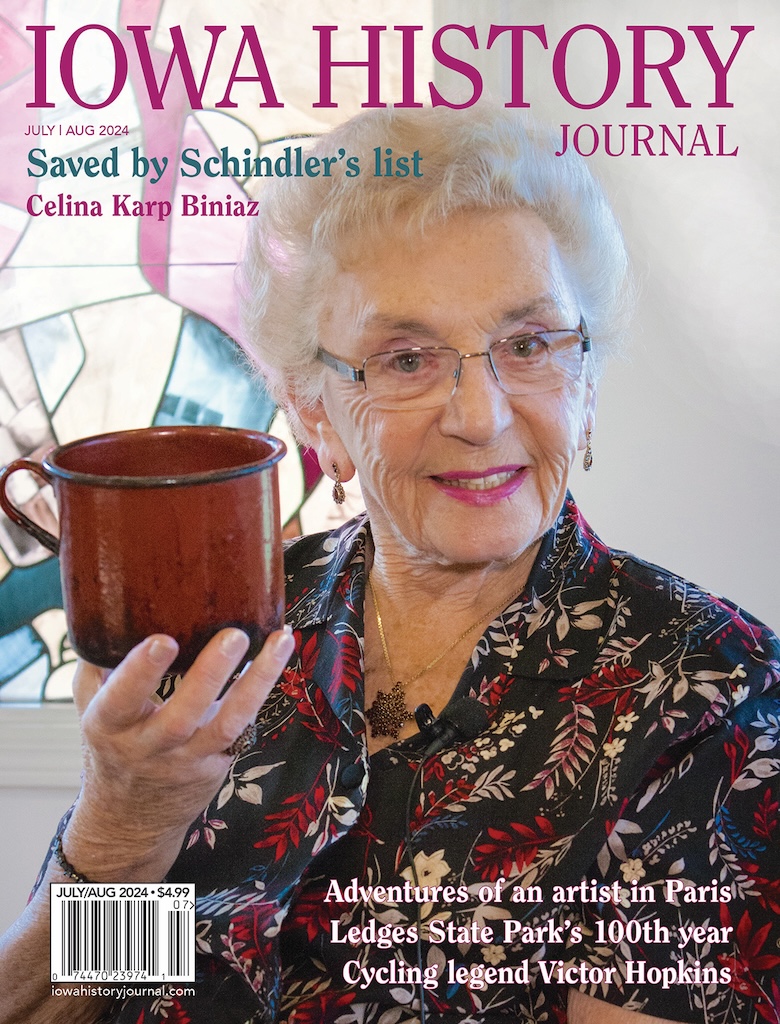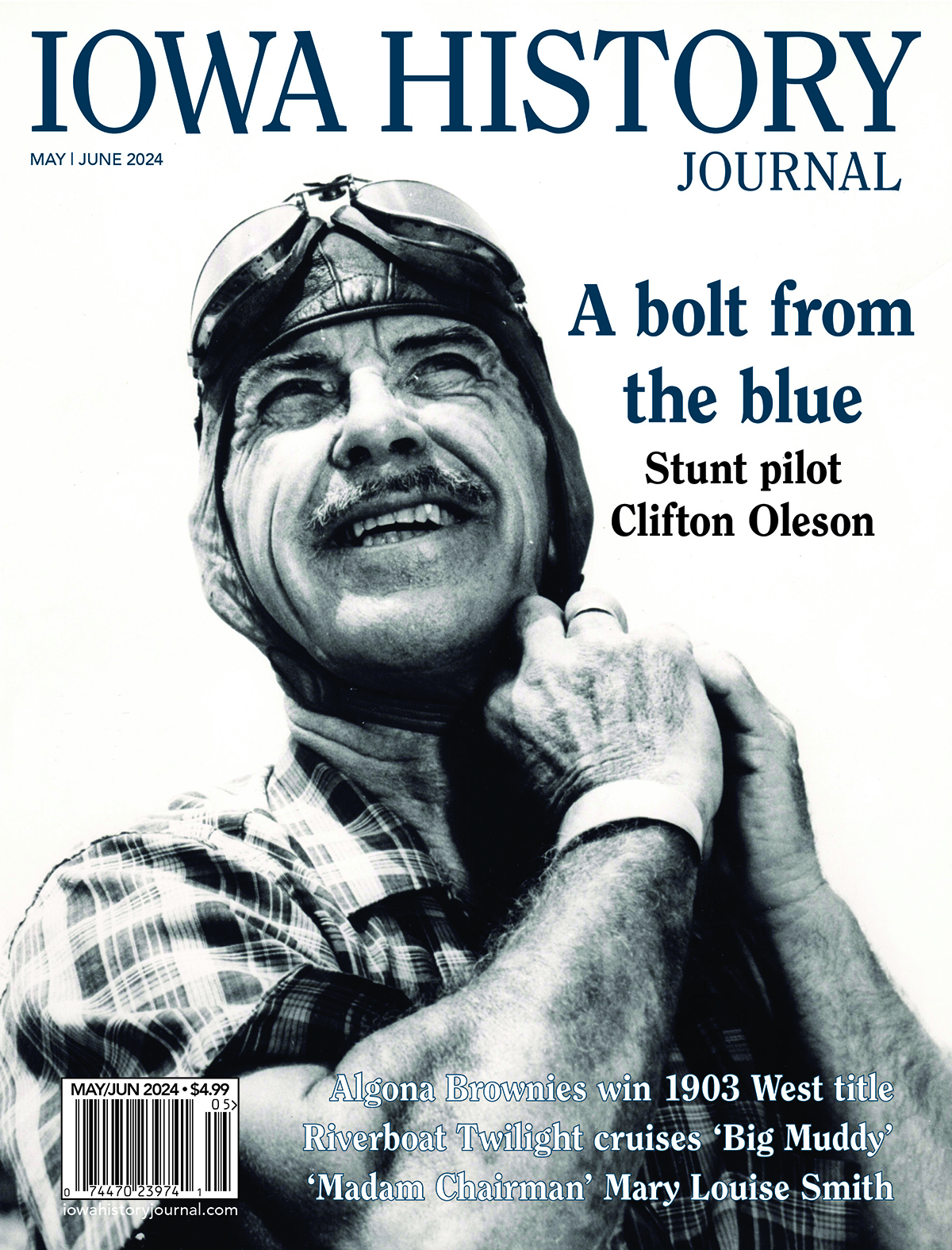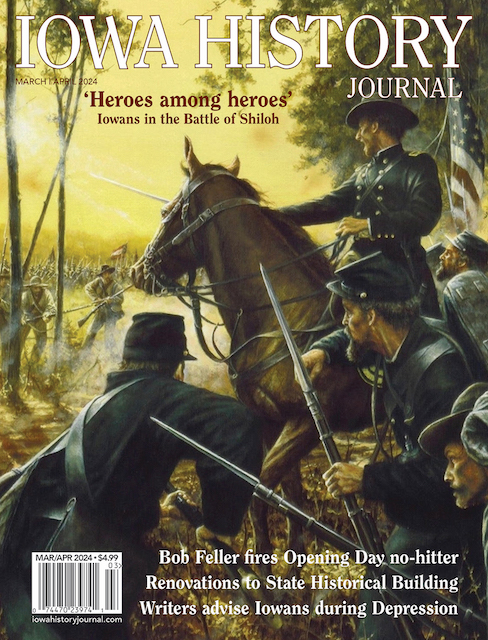 Volume 16, Issue No. 6, Nov/Dec 2024
Volume 16, Issue No. 6, Nov/Dec 2024
For 50 years, The Maintenance Shop in Ames has hosted a wide range of live music that has pleased the ears of generations of music fans. With its thrust stage adorned by a large stained-glass window, its pin-drop acoustics, and its audience seated closely to the musicians, the feeling of reverence, awe, and reflection, is what sets the M-Shop apart from other live music venues in Iowa. So, too, is the roster of legendary musicians who have played the M-Shop that is located in the basement of Iowa State University’s Memorial Union. They include Muddy Waters, Albert King, Willie Dixon, Buddy Rich, Charles Mingus, Chick Corea, Arlo Guthrie, Doc Watson, Leon Redbone, Billy Joe Shaver, War, Tower of Power, Dick Dale, Gregg Allman, Uncle Tupelo, Smashing Pumpkins and The Lumineers. Iowa History Journal Publisher Michael Swanger takes readers backstage to learn the history of one of Iowa’s most respected listening rooms.
In his column, publisher Michael Swanger recalls the many terrific shows that he has witnessed at The Maintenance Shop in Ames during the last 30 years.
Learn the story of Robert Schuller, the Iowa farm boy who became a world-famous preacher from Arvid Huisman.
The Glenn Miller series concludes as historian and author Dennis Spragg and debunks the conspiracy theories regarding the famous bandleader’s mysterious death 80 years ago.
Radio broadcaster and author Tim Harwood chronicles the University of Northern Iowa’s 1980-81 men’s basketball team that established the Panthers as a D-1 program.
“Country Roads” columnist Arvid Huisman writes about how Christmas music rekindles the spirit of the holiday.
TO READ MORE FASCINATING STORIES ABOUT IOWA HISTORY, subscribe to Iowa History Journal. You can also purchase back issues at the store.
 Volume 16, Issue No. 5, Sept/Oct 2024
Volume 16, Issue No. 5, Sept/Oct 2024
Clarinda native Glenn Miller, who scored more No. 1 records and Top 10 hits than either Elvis Presley or The Beatles, was America’s No. 1 bandleader from 1939 to 1942 before he joined the U.S. Army Air Forces to serve our nation during World War II and tragically died in a plane crash. On March 1, 1904, Alton Glenn Miller was born in the southwestern Iowa town of Clarinda. Although his parents would move along and raise him in Nebraska, Missouri and eventually Colorado, the man who became one of the foremost musical celebrities of the 20th century would always consider himself a proud Iowa native … as would idolizing media publicity. Miller fondly remembered Page and Montgomery counties as “cousin country,” and for good reason. Evidence of Miller’s cousins remains to this day in Clarinda and Red Oak. The first part of our in-depth, two-part series about the icon’s life and legacy, written by author and historian of the Glenn Miller Birthplace Society in Clarinda Dennis M. Spragg, chronicles Miller’s illustrious career and debunks conspiracies regarding his mysterious death.
In his column, publisher Michael Swanger congratulates the winners of this year’s Excellence in Iowa History Awards presented by the State Historical Society of Iowa Board of Trustees and reminds readers of Iowa History Journal’s annual sale of back issues this fall.
Explore the history of Forest Park Museum and Arboretum in Perry with Carson Ode. It’s home to 17 acres of re-established prairie and wildflowers.
Learn how former Iowa State head football coach Johnny Majors established the building blocks of Cyclones football for a legacy that lives on. Payne Blazevich, a senior at Iowa State University and sports reporter for Cyclone Alert/247Sports, tackles the fascinating subject.
Discover the life and career of actress and Montrose native Nedra Volz who found fame late in life on a series of popular TV shows, including “Diff’rent Strokes” and “All in the Family,” as chronicled by John Busbee, host of radio’s “The Culture Buzz.”
“Country Roads” columnist Arvid Huisman reminds readers to bloom where you are planted by recalling the many places we can call home.
Book reviews: “Broadlawns: A Century of Caring” and “Emigrant Tales of the Platte River Raids.”
TO READ MORE FASCINATING STORIES ABOUT IOWA HISTORY, subscribe to Iowa History Journal. You can also purchase back issues at the store.
 Volume 16, Issue No. 4, July/Aug 2024
Volume 16, Issue No. 4, July/Aug 2024
Poland native Celina Karp Biniaz was only 13 years old when she came face to face with notorious German SS officer officer and physician Joseph Mengele, the Nazi’s so-called “Angel of Death,” at Auschwitz concentration camp during World War II. As Celina passed by, he directed her to the side to be executed. But he then ordered the women to walk by again and Celina found the courage to say, “Let me go.” Remarkably, he did, and Celina survived. It is one of many harrowing moments Celina endured during the Holocaust. After the war, she found refuge in Des Moines, graduating from North High School and Grinnell College, and today she is one of the last surviving members of Schindler’s list. The 1993 movie “Schindler’s List” inspired her to speak publicly about her Holocaust experience, which she has shared with the Iowa Jewish Historical Society. William Friedricks, professor emeritus of history at Simpson College and author of Celina’s biography, “Saved by Schindler: The Life of Celina Karp Biniaz,” pens our cover story about Celina’s remarkable life from the Holocaust, to Des Moines, and beyond.
In his column, publisher Michael Swanger reminds Iowans to be mindful of history this summer while enjoying their favorite pastimes and vacations. You can also get the bonus exclusive Publisher’s Perspective: Failed assassination attempts, like the plot against Herbert Hoover, dot US history.
Explore Iowa’s second-oldest state park, Ledges State Park, which celebrates its centennial this year with Carson Ode.
Learn about artist William Edwards Cook’s adventures with the Lost Generation in Paris and his friendship with Gertrude Stein from retired art professor and author Roy Behrens.
retired Quad-City Times sports editor and author Don Doxsie tells the story of cycling legend Victor Hopkins, a Cedar Rapids, native who competed in the 1924 Olympics in Paris and won the World MotorPace championship.
“Country Roads” columnist Arvid Huisman pays tribute to his grandmother who never accumulated any wealth, but left her family an inheritance much greater than many.
Book reviews: John Busbee, host of radio’s “The Culture Buzz,” reviews the award-winning book by Jeff Bremer, “A New History of Iowa.”
TO READ MORE FASCINATING STORIES ABOUT IOWA HISTORY, subscribe to Iowa History Journal. You can also purchase back issues at the store.
 Volume 16, Issue No. 3, May/Jun 2024
Volume 16, Issue No. 3, May/Jun 2024
Like a bolt from the blue, McGregor native Clifton Oleson’s storied career as a pilot took off in 1917 when he became the youngest pilot in the U.S. at age 18. During his 50-year flying career he was a popular stunt pilot who performed death-defying aerial feats while barnstorming the Midwest. He also delivered air mail and trained cadets and tested airplanes for the U.S. military for two world wars. Though his career would take him around the world, it always brought him back to Iowa. Matthew Walsh, who teaches history at DMACC, tells the tale of Oleson’s ascension in the world of aviation during the 20th century for our cover story.
Publisher Michael Swanger writes his column about the significance of D-Day, the Allied invasion of Normandy to liberate France and Western Europe from Nazi Germany occupation during World War II, as the world commemorates its 80th anniversary
Get enlightened about the Riverboat Twilight, an essential American experience on the Mississippi River from LeClaire to Dubuque, from Emily Stier.
Author Timothy Walch reminds us of the remarkable political journey of Mary Louise Smith, the first female chair of the Republican National Committee
Discover the intrigue on and off the field around the Algona Brownies, an all-Black team that dominated the 1903 season and was crowned “Colored Champions of the West.” David Jepsen, Professor Emeritus, College of Education, University of Iowa, digs into baseball’s archives to craft this fascinating story.
“Country Roads” columnist Arvid Huisman recalls memories of summer Sundays with his cousins during family reunions.
Book reviews: Steve Dunn’s book about the history of baseball in Des Moines from John Busbee. Michael Swanger reviews Jerry Harrington’s biography of former Iowa Gov. Harold Hughes.
TO READ MORE FASCINATING STORIES ABOUT IOWA HISTORY, subscribe to Iowa History Journal. You can also purchase back issues at the store.

North Carolina historical artist Artist Dan Nance, captures the essence of the Battle of Shiloh. Visit dannance.com to see more of his work.
Volume 16, Issue No. 2, Mar/Apr 2024
No state, per capita, mustered more men to fight in the American Civil War than did Iowa. What’s more, Iowans participated in some of the war’s most bloody conflicts including the Battle of Shiloh on April 6-7, 1862, in an area located between a small church named Shiloh and Pittsburg Landing on the Tennessee River. More than 6,660 Iowa troops — by far the largest concentration of Iowa soldiers to fight in any battle in any war — fought in the Battle of Shiloh.
Award-winning writer Don Doxsie takes readers behind the scenes of the epic battle for our cover story, detailing the roles that Iowans played during the battle and afterwards to preserve the memories of those who paid the ultimate sacrifice to preserve the Union.
Publisher Michael Swanger marks the centennial of WHO Newsradio 1040 in his column.
Get the frame-by-frame account of Major League Baseball Hall of Fame pitcher Bob Feller’s Opening Day no-hitter on April 16, 1940, the first of its kind in MLB history from publisher Michael Swanger.
Have you heard of The Iowa Homemaker? Iowa State University history student Samuel Poage digs into ISU’s archives to tell the little-known story about the Fergusons, the ISU couple who wrote farm and home advice stories to help rural citizens survive the Great Depression.
Take a tour of the recently renovated, fully reopened State Historical Building of Iowa in downtown Des Moines that houses the state’s historical society, museum, library and archives from State Historical Society of Iowa Public Information Officer, Jeff Morgan.
Country Roads columnist Arvid Huisman urges the arrival of spring and shares his growing loathing for winter.

Volume 16, Issue No. 1, Jan/Feb 2024
Nearly 90 years after the most famous bank robber in U.S. history, John Dillinger, robbed the First National Bank in Mason City on March 13, 1934, the events of that day remain etched into the fabric of the town’s history. The Dillinger Gang stole $52,000 in cash and captured several hostages as they shot their way out of Mason City. It was one of a dozen bank robberies committed by the Dillinger Gang in the Midwest from June 1933 to June 1934 during the depths of the Great Depression. Newspaper reports of the brazen crime committed during broad daylight in the serene northern Iowa town and the gang’s subsequent escape captivated the imagination of readers across the nation and the ire of federal and state law enforcement officials. Soon afterwards, it helped give rise to Dillinger’s status as the nation’s first “Public Enemy No. 1” with the newly formed F.B.I. hot on his trail. Iowa History Journal Publisher Michael Swanger tells the story of the Dillinger Gang’s robbery in Mason City and its time spent in Iowa during its infamous crime spree, which reinforced the public’s fascination with outlaws, gangsters and other anti-heroes.
Publisher Michael Swanger devotes his column to visit state historical markers, including one that recognizes the Historic Center Street Neighborhood which was a vibrant business and cultural hub for the Black community in Des Moines during the 20th century.
Did you know Johnny Carson won this contest? Jeff Stein, radio host on News/Talk 1540 KXEL in Waterloo and Cedar Rapids, recalls when television talk show host Johnny Carson won a contest to be named Cooper’s 51st resident in 1981 as the small town celebrated its centennial that year.
Jerry Harrington, author of the new book, “Thunder from the Prairie: The Life of Harold E. Hughes,” dives into how former Gov. Hughes launched a statewide crusade against racism during the late 1960s with a series of conferences.
Take a behind-the-scenes-look at Doyle “Doc” Allsup, Iowa’s athletic trainer for the “Ironmen” and Rose Bowl champs of the 1950s, from first-time contributor Mark Petersen and grandson of Allsup.
Read the review of the latest compelling book written by Joy Neal Kidney, “What Lenora Never Knew.”
Country Roads columnist Arvid Huisman reminds readers to enjoy the little things in life as someday they may realize they were big things.
TO READ MORE FASCINATING STORIES ABOUT IOWA HISTORY, subscribe to Iowa History Journal. You can also purchase back issues at the store.
